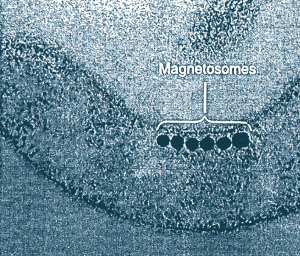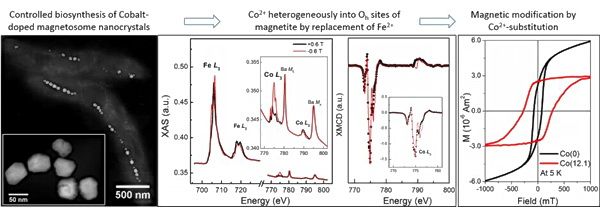
A chain of magnetosomes (Image: xmwb.xinmin.cn)
The biomineralization of magnetite nanocrystals (called magnetosomes) by magnetotactic bacteria (MTB) has attracted intense interest in biology, geology and materials science due to the precise morphology of the particles, their chain-like assembly and their unique magnetic properties. For instance, by using the magnetosome chain(s), MTB cells orient themselves and can navigate along Earth’s magnetic field lines when they are swimming in aquatic environments. The fossil remains of MTB (known as magnetofossils) have been used to retrieve paleomagnetic and paleoenvironmental information from ancient sediments. As an intriguing model system, MTB have therefore been extensively studied to better understand magnetite biomineralization and geomagnetic sensitivity in organisms. Recently, MTB have also been modified for producing physically and biologically tailored magnetic nanoparticles for biomedical and biotechnological applications.
In the past decade, great efforts have been made in producing transition metal-doped magnetosomes with modified magnetic properties for a range of applications. Despite some successful outcomes, the coordination chemistry and magnetism of such metal-doped magnetosomes still remains largely unknown.
Prof. PAN Yongxin’s lab carried out a systematic study on the cobalt doping in magnetosome magnetite within M. magneticum AMB-1 by the combination of (S)TEM, bulk magnetic measurements, and element- and site-specific XMCD analyses. All the data are consistent and clearly reveal that (1) trace amounts of cobalt within the initial growth medium (i.e., 2.1 µM) can significantly improve both the cell growth and magnetosome formation; (2) Co2+ ions can be exclusively incorporated into Oh sites of magnetosome magnetite through the replacement of Fe2+ ions; (3) Co2+ ions occur in the spinel structure of magnetosome heterogeneously (i.e., they vary in the amount of different particles and enrich at the surface of individual ones); and (4) the controlled doping of Co2+ in Oh sites of magnetosome magnetite resulted in a pronounced increase in magneto-crystalline anisotropy and magnetic coercivity. These results indicate that MTB may provide a promising biomimetic system for precisely producing chains of Co2+-doped SD magnetite which have optimized magnetic properties (i.e., enhanced coercivity but not-too-low saturation magnetization, as well as uniaxial in-plane anisotropy).
This study has been recently published online in the Journal of the Royal Society Interface. (Li JH, Menguy N, Arrio MA, Sainctavit P, Juhin A, Wang YZ, Chen HT, Bunau O, Otero E, Ohresser P, Pan YX, Controlled cobalt doping in the spinel structure of magnetosome magnetite: New evidences from element- and site-specific XMCD analyses, J. R. Soc. Interface, 2016, 13(121), doi. 10.1098/rsif.2016.0355.) (Link)
This study was financially supported by the National Natural Science Foundation of China (grants 41522402, 41374004 and 41330104) and the Open Project Support from the State Key Laboratory of Lithospheric Evolution (SKLLE, Beijing).

Three images explain the research process(Image by LI et al.)
Contact:
LI Jinhua
Division of the Earth's Deep Structure and Process
Institute of Geology and Geophysics, Chinese Academy of Sciences
Tel: +8610-82998323
E-mail: lijinhua@mail.iggcas.ac.cn